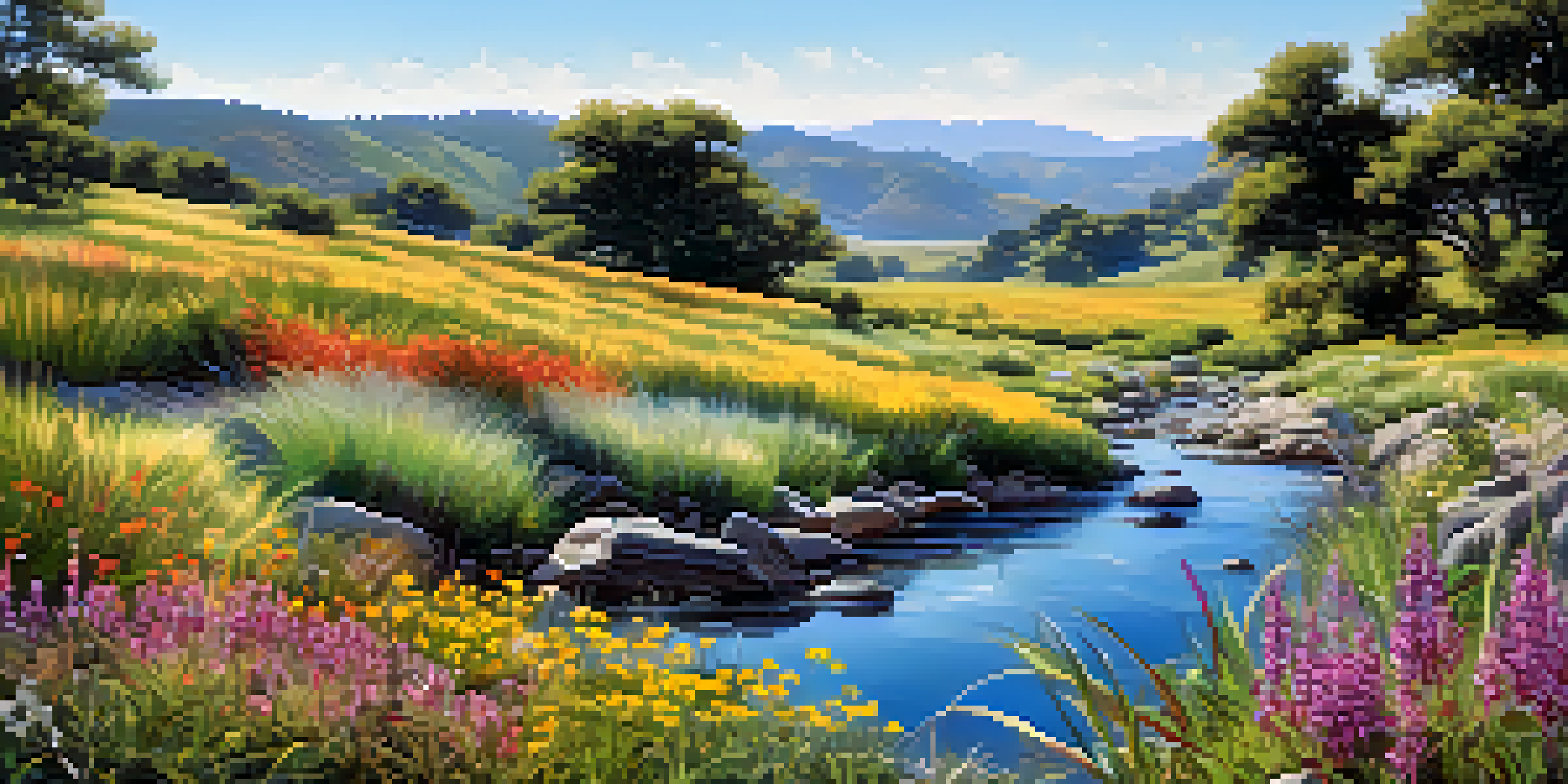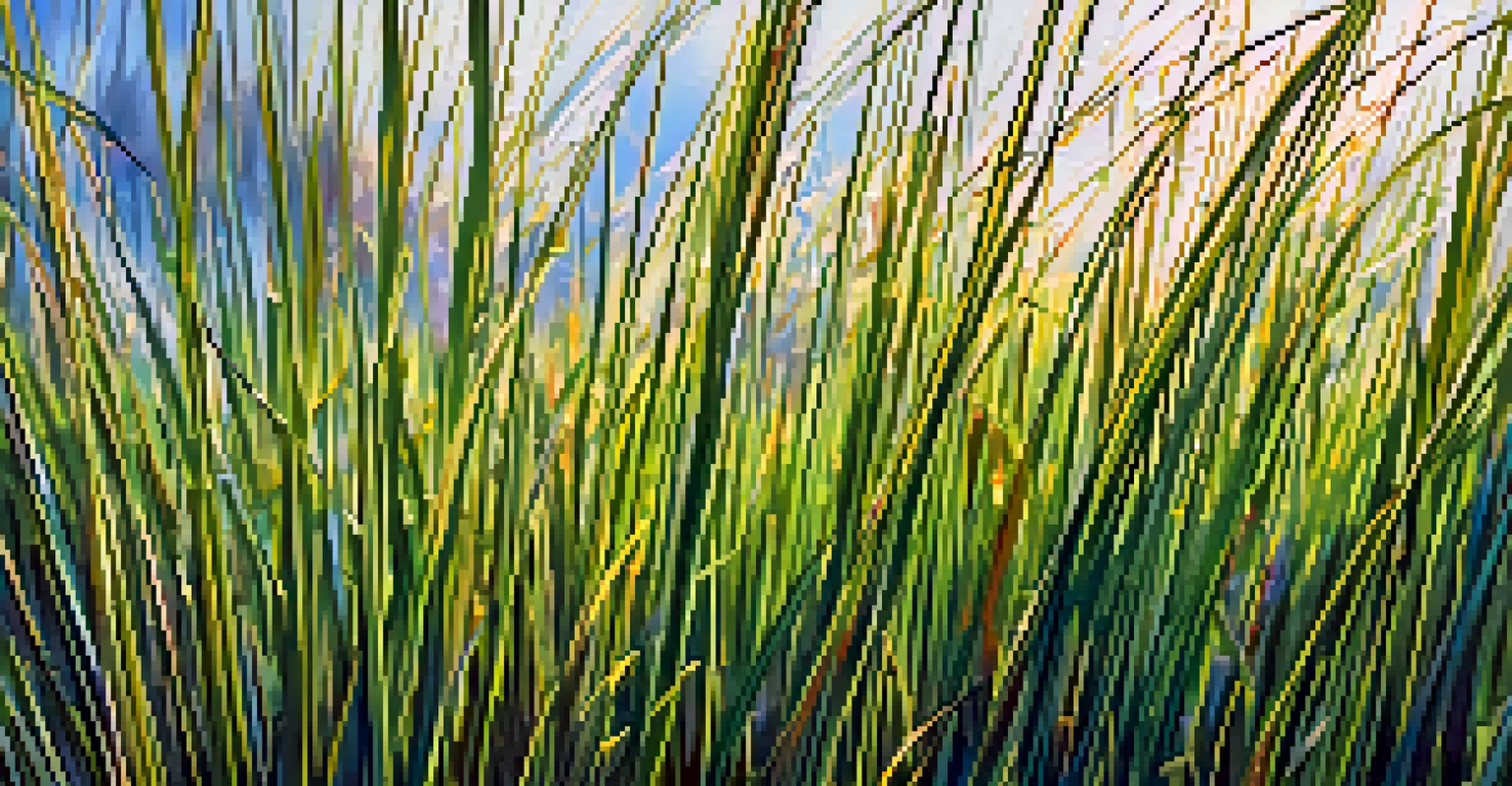Using Native Plants to Combat Erosion in Landscapes

Understanding Erosion and Its Impact on Landscapes
Erosion is a natural process where soil and rock are worn away, often exacerbated by human activities. It can lead to significant landscape changes, loss of fertile soil, and water quality issues. When soil erodes, it can disrupt local ecosystems, making it challenging for plants and wildlife to thrive.
The earth has music for those who listen.
The impact of erosion isn't just environmental; it can also affect agricultural productivity and property values. For instance, a garden or farm that suffers from erosion may yield less produce, affecting food supply and income. Additionally, eroded landscapes can result in increased sediment in rivers and streams, harming aquatic life.
Understanding the causes of erosion is essential for effective management. Factors such as heavy rainfall, wind, and human activity like deforestation can all contribute to soil loss. By exploring solutions, we can help protect our landscapes and the biodiversity they support.
What Are Native Plants and Why Are They Important?
Native plants are species that naturally occur in a specific region and have adapted to local environmental conditions. They play a crucial role in maintaining the health of ecosystems by supporting wildlife and promoting biodiversity. By using native plants in landscaping, we can create resilient environments that thrive without excessive maintenance.

One of the key benefits of native plants is their ability to establish deep root systems, which help hold soil in place and reduce erosion. For example, a native grass like Big Bluestem can extend its roots up to 10 feet deep, providing stability to the soil. This natural anchoring is vital in areas prone to erosion, such as riverbanks and slopes.
Erosion's Impact on Landscapes
Erosion disrupts ecosystems, reduces agricultural productivity, and degrades water quality.
Moreover, native plants require less water and fewer chemicals than non-native species, making them a sustainable choice for landscaping. They are well adapted to local climate conditions, which means they can thrive with minimal intervention. This not only conserves resources but also encourages the growth of other beneficial species in the area.
How Native Plants Stabilize Soil and Prevent Erosion
The deep root systems of native plants play a pivotal role in soil stabilization. These roots weave through the soil, creating a network that holds it together, reducing the risk of erosion during heavy rains. For example, plants like sedges and rushes can thrive in wet areas where soil is especially vulnerable, effectively anchoring the ground.
Adopt the pace of nature: her secret is patience.
In addition to their roots, native plants also help improve soil structure. As they grow, their decaying leaves and organic matter enrich the soil, making it more resilient to erosion. This natural process not only fortifies the soil but also promotes a healthy ecosystem, where other plants and animals can thrive.
Incorporating native plants into landscapes can significantly mitigate erosion risks. For instance, creating a buffer zone with native shrubs near waterways can slow down water runoff and trap sediment, preventing it from washing away. This approach not only protects the soil but also enhances the beauty and biodiversity of our surroundings.
Practical Steps to Implement Native Plants in Your Landscape
To begin incorporating native plants into your landscape, start by researching which species are indigenous to your area. Local extension services or native plant societies can provide valuable resources and guidance. Choosing the right plants for specific conditions, such as sun or shade, is essential for their success.
Once you've selected your native plants, consider creating a planting plan that focuses on their placement. Grouping plants with similar water and light needs can help them thrive. For example, placing drought-tolerant species together allows for efficient water management, while moisture-loving plants can be positioned in wetter areas.
Benefits of Native Plants
Native plants stabilize soil, require less maintenance, and enhance biodiversity, making them ideal for landscaping.
Finally, after planting, maintain your native garden by monitoring its growth and addressing any issues that arise. Native plants are generally low-maintenance, but occasional weeding or mulching can enhance their health. Embracing this natural approach not only combats erosion but also creates a vibrant and resilient landscape.
Success Stories: Communities Using Native Plants to Combat Erosion
Many communities have successfully implemented native plant strategies to combat erosion, creating beautiful, sustainable landscapes. One notable example is the restoration projects along the Chesapeake Bay, where local governments and organizations have planted thousands of native species to stabilize shorelines and improve water quality. These efforts not only protect the environment but also enhance recreational spaces for the community.
Another inspiring story comes from a neighborhood in California that faced severe erosion issues due to urban development. By converting a barren hillside into a native plant garden, residents not only reduced erosion but also created a habitat for local wildlife. This transformation demonstrated how community action can lead to significant environmental benefits.
These success stories highlight the potential of native plants to bring about positive change. By sharing these experiences, we can inspire others to consider native landscaping as a viable solution to erosion and environmental degradation.
The Role of Education in Promoting Native Plant Use
Education plays a vital role in promoting the use of native plants for erosion control. Workshops, community seminars, and school programs can raise awareness about the benefits of native landscaping. By engaging individuals of all ages, we can foster a deeper understanding of our ecosystems and the importance of biodiversity.
Local organizations often host events where community members can learn about native plants, their benefits, and how to incorporate them into their own landscapes. These educational initiatives can empower individuals to take action in their own yards, leading to a broader movement towards sustainable gardening practices.
Community Success with Native Plants
Communities have effectively used native plants to combat erosion, improve habitats, and promote sustainability.
Moreover, schools can integrate native plant education into their curricula, encouraging students to explore their local environment. Projects that involve planting native gardens can instill a sense of stewardship in young minds, ensuring the next generation values and protects their natural surroundings.
Conclusion: Embracing Native Plants for a Greener Future
In conclusion, using native plants is not just a beautiful choice for landscaping; it's a powerful tool in the fight against erosion. By understanding the role of these plants in stabilizing soil and supporting local ecosystems, we can make informed decisions that benefit both our landscapes and the environment. It's a win-win situation.
As more communities recognize the benefits of native plants, we can collectively work towards healthier, more resilient landscapes. Whether you are a homeowner, a gardener, or a community leader, embracing native species can lead to lasting positive impacts. The journey toward sustainability starts with small, intentional steps.

So, let's take action! Consider incorporating native plants in your next landscaping project, and inspire others to do the same. Together, we can combat erosion, enhance biodiversity, and create greener, more sustainable communities for generations to come.